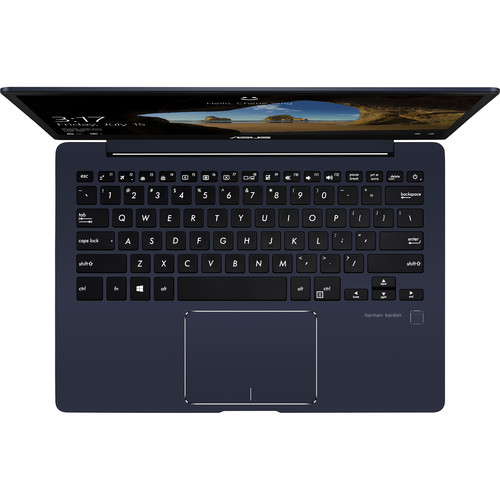Description
ASUS ZenBook 13 Overview
Measuring just 0.5″ thin and weighing just 2.5 pounds, the ASUS 13.3″ ZenBook 13 UX331UN Multi-Touch Notebook features a royal blue finish with a glossy coating. In addition to its ultraportable design, the ZenBook 13 also features a dedicated NVIDIA GeForce MX150 graphics card with 2GB of GDDR5 VRAM.
The 13.3″ NanoEdge display features slim bezels for an 80% screen-to-body ratio. This allows you to fully enjoy the Full HD 1920 x 1080 resolution and 16:9 aspect ratio. You can also output to an external display via the HDMI 1.4 port.
The system is powered by an 8th Gen Kaby Lake R 1.6 GHz Intel Core i5-8250U quad-core processor. It also has 8GB of LPDDR3 RAM, a 256GB M.2 SSD, a microSD card slot, 802.11ac Wi-Fi, Bluetooth 4.2, USB 3.0 Type-C, and USB 3.0 Type-A. The Chiclet-style keyboard is backlit and there is also a built-in fingerprint reader that works with Windows Hello. Windows 10 Home (64-bit) is the installed operating system.
ASUS ZenBook 13
8th Gen Kaby Lake R Quad-Core Intel Core i5 Performance
The system houses an 8th Gen Kaby Lake R Intel Core i5-8250U processor. Its quad cores can reach a stock speed of 1.6 GHz. It can be boosted up to 3.4 GHz.
13.3″ Full HD Multi-Touch Display
The 13.3″ display features a Full HD 1920 x 1080 screen resolution and a 16:9 aspect ratio, powered by a dedicated NVIDIA GeForce MX150 graphics card with 2GB of GDDR5 VRAM. The screen also has multi-touch support and a glossy finish.
Dual-Band 802.11ac Wi-Fi & Bluetooth 4.2
Featuring dual-band 802.11ac Wi-Fi, the ZenBook 13 delivers higher performance, broader coverage, and longer battery life than previous Wi-Fi standards. The ZenBook 13 also comes with Bluetooth 4.2 technology, so you’ll be able to connect wirelessly to Bluetooth-compatible peripherals and accessories.
Design
The ZenBook 13 measures in at 0.5″ thin and weighs just 2.5 pounds. It also features a 6.86mm slim-bezel NanoEdge display, which gives it an 80% screen-to-body ratio. The royal blue finish has a crystal-like glossy coating, which was created using a nano-imprinted lithography process.
Windows 10
Start Menu
After its hiatus in Windows 8, the Start Menu has returned. Utilizing a combination of the traditional menu system and Windows 8’s Live Tiles, the improved Start Menu gives you more information at a glance, showing notification information alongside your applications and other pinned items.
Cortana
Microsoft’s digital personal assistant, Cortana can answer your questions with information gleaned from both your device and the internet at large. You can type or even talk with her, if your system has a microphone. Using her Notebook, Cortana keeps track of your needs and wants, and she learns over time to improve her information gathering skills.
Microsoft Edge
After nearly 20 years, Microsoft has finally replaced its Internet Explorer web browser. With Microsoft Edge, users can write directly on web pages and share notes with friends and colleagues. It also improves the online reading experience by adding a distraction-free mode and read-it-later functionality. Edge also has built-in Cortana integration; you can have her help you find a restaurant, make a reservation, and pull up directions without leaving your browser.
Windows Store
For Windows 10, Microsoft has unified the Windows Store. Now, apps for PCs, tablets, and phones will all be accessible from one place. And with support for Universal Apps, one version of an app can work across all your compatible devices automatically.
Windows Continuum
Windows 10 was designed for a variety of screen sizes and input styles, and with its Continuum feature, it automatically adapts to fit your needs. A Windows 10 tablet on its own requires a touch-centric approach, but attaching a mouse and keyboard will shift everything to a more traditional interface. You can even attach an external monitor to your Windows 10 phone for a near-desktop experience. But it’s not just the operating system; Windows Universal Apps take advantage of Continuum as well.
Xbox on Windows 10
Gaming is a big focus of Windows 10. Xbox integration allows for PC players to match up against Xbox One players on supported games, and if you have an Xbox One, you can even stream compatible titles to your PC. Native support for recording with the new Game DVR feature makes it easy to capture and share your gameplay. The new DirectX12 takes better advantage of multi-core processors, giving games a performance boost, even on older hardware. Windows 10 also features native support for virtual reality headsets, such as the Oculus Rift.




















